

IoT. Tara TAUBMAN-BASSIRIAN LLM on LinkedIn: Courtyard by Marriott St. George adopts advanced IoT door lock technology.
IoT garage door connected. NEST. Connected bandage. How to make IoTSmart devices more secure? Wearables. Connected toys. Smart headphones. Smart Cities. Smart toilet. Robot vaccum. Smart door bells. Conversational agents. Connected cars. Smart bulbs. Smart Meter data. Smart bed. Medical IoT. Smart TVs. Smart meter. IoT. Plus d'objets connectés que d'humains sur Terre.
Selon Gartner, 8,4 milliards d’objets seront connectés dans le monde d’ici fin 2017.
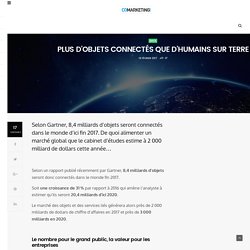
De quoi alimenter un marché global que le cabinet d’études estime à 2 000 milliard de dollars cette année… Selon un rapport publié récemment par Gartner, 8,4 milliards d’objets seront donc connectés dans le monde fin 2017. Soit une croissance de 31 % par rapport à 2016 qui amène l’analyste à estimer qu’ils seront 20,4 milliards d’ici 2020. Le marché des objets et des services liés générera alors près de 2 000 milliards de dollars de chiffre d’affaires en 2017 et près de 3 000 milliards en 2020.
Le nombre pour le grand public, la valeur pour les entreprises En termes de volume, ce sont les objets connectés grand public qui ont été le plus représentés (3,96 milliards) en 2016, devant ceux utilisés par les entreprises (plus de 2,4 milliards). En valeur cette fois, le marché de l’IoT tourne à l’avantage des applications professionnelles. 45 Fascinating IoT Statistics for 2021. The last few years have seen the Internet of Things vision grow from a theoretical concept to a major priority for many organizations.

As companies integrate IoT devices into their network infrastructures, they’re looking for new ways to use and manage the data they collect. Since IoT-enabled devices can connect to a broader network, they can achieve extensive functionality. However, that brings a whole new challenge: securing all that data. 10 Smart Accessories for Your Car. L’Internet des Objets un formidable levier business pour les entreprises. Avec Internet, 7 milliards de personnes peuvent communiquer, échanger des informations, accéder à des services, s’ils disposent de l’énergie et des outils pour pouvoir le faire.
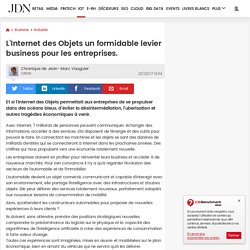
En connectant les machines et les objets se sont des dizaines de milliards d’entités qui se connecteront à internet dans les prochaines années. Des chiffres qui nous propulsent vers une économie totalement nouvelle. Les entreprises doivent en profiter pour réinventer leurs business et accéder à de nouveaux marchés. Miele's networked disinfecting hospital dishwasher has a gaping security flaw... The Miele PG 8528 is a "washer-disinfector" intended for hospitals and other locations with potentially dangerous pathogens on their dirty dishes; it's networked and smart.
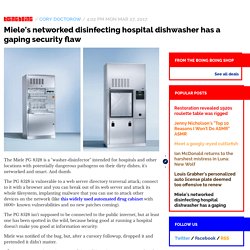
And dumb. The PG 8528 is vulnerable to a web server directory traversal attack; connect to it with a browser and you can break out of its web server and attack its whole filesystem, implanting malware that you can use to attack other devices on the network (like this widely used automated drug cabinet with 1600+ known vulnerabilities and no new patches coming).
The PG 8528 isn't supposed to be connected to the public internet, but at least one has been spotted in the wild, because being good at running a hospital doesn't make you good at information security. L’internet des objets : la 3ème révolution informatique – 27 avril 2017. Circle City Con 50 108 IoT 4n6 The Growing Impact of the Internet of Things on Digital Forensics Jes. IoT Application Using Watson IoT & IBM Blockchain. The Internet of Things (IoT) has opened up countless opportunities for businesses to drive smarter operations.
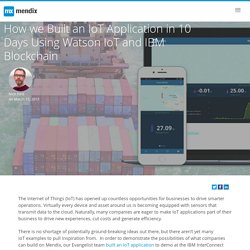
Virtually every device and asset around us is becoming equipped with sensors that transmit data to the cloud. Naturally, many companies are eager to make IoT applications part of their business to drive new experiences, cut costs and generate efficiency. There is no shortage of potentially ground-breaking ideas out there, but there aren’t yet many IoT examples to pull inspiration from. In order to demonstrate the possibilities of what companies can build on Mendix, our Evangelist team built an IoT application to demo at the IBM InterConnect show next week. Le fil. What is the Internet of Things (IoT) How It Works In IoT discussions, it’s recognized from the onset that analytics technologies are critical for turning this tide of streaming source data into informative, aware and useful knowledge.
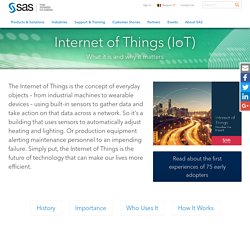
But how do we analyze data as it streams nonstop from sensors and devices? How does the process differ from other analytical methods that are common today? In traditional analysis, data is stored and then analyzed. However, with streaming data, the models and algorithms are stored and the data passes through them for analysis. So before the data is stored, in the cloud or in any high-performance repository, you process it automatically. Amazon Sidewalk: What It Is, What It Does, How to Opt-Out.
Your 'smart home' is watching – and possibly sharing your data with the police. You may have a roommate you have never met.
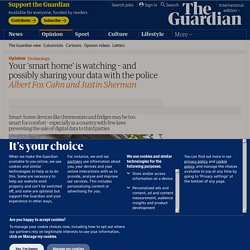
And even worse, they are nosy. They track what you watch on TV, they track when you leave the lights on in the living room, and they even track whenever you use a key fob to enter the house. This is the reality of living in a “smart home”: the house is always watching, always tracking, and sometimes it offers that data up to the highest bidder – or even to police. This problem stems from the US government buying data from private companies, a practice increasingly unearthed in media investigations though still quite shrouded in secrecy. It’s relatively simple in a country like the United States without strong privacy laws: approach a third-party firm that sells databases of information on citizens, pay them for it and then use the data however deemed fit.
“Modern surveillance” might evoke images of drones overhead, smartphones constantly pinging cell towers, and facial recognition deployed at political protests. Specifio. 8259B (Draft), IoT Non-Technical Supporting Capability Core Baseline. Date Published: December 2020 Comments Due: Email Questions to: Planning Note (2/8/2021): The comment period has been extended to February 26, 2021.
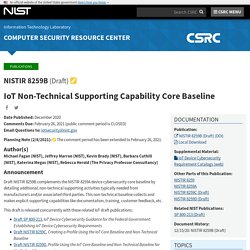
Author(s) Michael Fagan (NIST), Jeffrey Marron (NIST), Kevin Brady (NIST), Barbara Cuthill (NIST), Katerina Megas (NIST), Rebecca Herold (The Privacy Professor Consultancy) Announcement Draft NISTIR 8259B complements the NISTIR 8259A device cybersecurity core baseline by detailing additional, non-technical supporting activities typically needed from manufacturers and/or associated third parties. La vérité sur…l’échec des objets connectés - Challenges.fr. Dans l'univers des objets connectés, la créativité est sans limites.
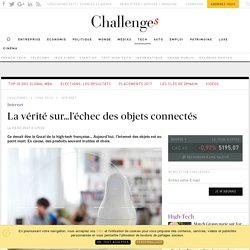
Pour s'en rendre compte, il suffisait de déambuler dans les allées du Consumers Electronic Show (CES), la grand-messe annuelle de l'électronique grand public, qui a réuni à Las Vegas, du 5 au 8 janvier, des geeks venus du monde entier. Ici, Energysquare qui propose un chargeur sans fil pour mobile, là, Hydrao qui a mis au point le premier pommeau de douche. Industrial Internet. Industrial Internet, Internet of Things and Industrie 4.0 The Internet of Things (IoT) refers to the digitalization and virtualization of business processes (B2B) and customer experience (B2C) by connecting devices and assets (e.g. sensor equipped machinery, robots, wearables).
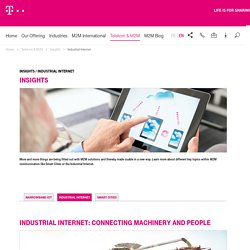
These relatively new IoT services are enabled by connectivity, platforms and data analytics for a large amount of data in real-time. Whereas IoT covers both B2B and B2C contexts, Industrial Internet and Industrie 4.0 only refer to the digitalization of the business to business aspect. In general, Industrial Internet and Industrie 4.0 have the same key ingredients – the only differentiator between both concepts is the addressee: Industrial Internet refers to industry and service sector, whereas Industrie 4.0 only refers to the manufacturing industry. Un tatouage tactile pour contrôler à distance les objets connectés. Uk.businessinsider. The Internet of Things (IoT) has been labeled as "the next Industrial Revolution" because of the way it will change the way people live, work, entertain, and travel, as well as how governments and businesses interact with the world.
In fact, the revolution is already starting. That brand new car that comes preloaded with a bunch of apps? IoT (II): from the internet of things to the internet of bodies. The advancement of hyperconnected technology is increasing these days. The Internet of Things or “IoT” is a reality that has reached our houses through all sorts of “intelligent” devices that we may find even in supermarkets but also in vehicles and on our bodies. In this last case, new risks for the rights and freedoms arise that could be a risk for health. “The Internet of Things” or “Internet de las Cosas” (IoT) is a concept proposed in 1999 by Kevin Ashton to describe the phenomenon of digital interconnection between the objects of the physical world and the Internet.
The increasing surge of connected devices that can be used to control aspects regarding well-being and health by wearing them has given rise to the concept of the Internet of Bodies, IoB, or connected body. IoT Device Criteria. As part of its assignment under the Presidential Executive Order on Improving the Nation’s Cybersecurity (14028 issued on May 12, 2021, NIST has released a white paper with draft criteria for a labeling program on cybersecurity capabilities of Internet-of-Things (IoT) devices.
This is one part of a multi-faceted initiative under the executive order related to cybersecurity labeling for consumers. NIST is seeking comments on the draft criteria, which suggests a set of potential baseline security criteria for IoT devices. Comments on the draft white paper are due no later than October 18, 2021. Under the Executive Order, NIST is to publish details about the IoT labeling effort by February 6, 2022. Comments should be submitted to: labeling-eo@nist.gov.
Objets connectés : la 3ème révolution informatique – 2 mars 2017. Les véritables enjeux stratégiques des Objets Connectés ne se situent pas là où on les attend. Ils ne résident pas au niveau des objets ou des réseaux, mais dans l’Analytique des Objets et l’Action Cognitive qui en découle. IoT by AEPD. 8259B (Draft), IoT Non-Technical Supporting Capability Core Baseline. Www.zdnet.
This year's Amazon hardware event was quite a doozy. The Seattle-based company showcased an updated health band with a nutritionally-guided personalized shopping service, a flying security drone, more indoor and outdoor cameras, and an autonomous sentry robot. All of which are powered in some way by AWS machine learning and left me thinking about one word: privacy.
Ring, Echo and Astro: Everything Amazon just announced Do I really want all of these products in my own home and as part of my life? Admittedly, there is a certain appeal to Amazon's pitch of having their technology live in the background, transparently, to enable our real-world experiences better. Granted, I've already accepted a lot of these devices into my life. But so far, I have resisted the notion of having cameras all over the place, peering inside the home's interior spaces. Part of this stems from the fact that I have no children, so I do not need to check up on them. It's not just the cameras, though. Fridge ordering your milk. Internet of Things. Data stored by copymachines HD. Microsoft Kinect eavesdropping. Internet of things. Wearable AI that can detect the tone of a conversation. It’s a fact of nature that a single conversation can be interpreted in very different ways.
For people with anxiety or conditions like Asperger’s, this can make social situations extremely stressful. But what if there was a more objective way to measure and understand our interactions? Researchers from MIT’s Computer Science and Artificial Intelligence Laboratory (CSAIL) say that they’ve gotten closer to a potential solution: an artificially intelligent wearable system that can predict if a conversation is happy, sad or neutral based on a person’s speech patterns and vitals.
“Imagine if, at the end of a conversation, you could rewind it and see the moments when the people around you felt the most anxious,” says graduate student Tuka Alhanai, who co-authored a related paper with PhD candidate Mohammad Ghassemi that they will present at next week’s Association for the Advancement of Artificial Intelligence (AAAI) conference in San Francisco.
How it works. It's not just your TV that can track your habits without consent. If you want to know what products and services are tracking you without your consent, their privacy policies are a good place to start. Own a PlayStation? Sony can share "non-personally identifying information and behavioural data from our studies with our affiliates and other third parties. " Belkin — which makes a line of smart light switches and power plugs under the WeMo brand — may also share "aggregated and anonymized non-personal information" about how you use its products with third parties. Similarly, "service providers, business partners and other trusted affiliates" might know how often you turn your smart light bulb on or off if you own a Philips Hue. But privacy policies only tell part of the story. Lawyers Ready to Pounce if Companies Forget IoT Privacy. By Joyce E. Cutler Consumers increasingly tune out privacy risks from internet-connected devices, and companies that don’t take up the privacy torch may be creating liability, attorneys told Bloomberg BNA.
The Internet of Things' Dangerous Future: Bruce Schneier. Last year, on October 21, your digital video recorder — or at least a DVR like yours — knocked Twitter off the internet. Someone used your DVR, along with millions of insecure webcams, routers, and other connected devices, to launch an attack that started a chain reaction, resulting in Twitter, Reddit, Netflix, and many sites going off the internet. You probably didn’t realize that your DVR had that kind of power. But it does. All computers are hackable. This has as much to do with the computer market as it does with the technologies. In this article I want to outline the problems, both technical and political, and point to some regulatory solutions. Can Your 'Smart' Appliances Be Trusted with Your Personal Data? Probably Not... Your fridge is getting so smart, security-software maker Kaspersky Lab thinks you probably shouldn’t trust it. As makers of household appliances fill their machines with computer chips to make them smarter, consumers and privacy watchdogs should beware the data collected by these objects and how it’s used, Marco Preuss, a director on Kaspersky’s global research and analysis team in Europe, said at the IFA consumer electronics conference in Berlin.
Cheap Internet of Things gadgets betray you even after you toss them in the trash. Cpomagazine.